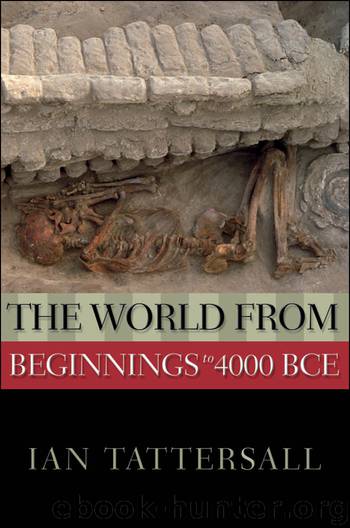World from Beginnings to 4000 BCE by Tattersall Ian;

Author:Tattersall, Ian;
Language: eng
Format: epub
Publisher: Oxford University Press, USA
Published: 2008-08-01T16:00:00+00:00
Hut-like structures like these were probably made by Homo heidelbergensis 400,000 years ago. These shelters, built on an ancient beach at Terra Amata, in southern France, were up to 25 feet long. The cutaway reveals an interior containing a circular hearth and stone tools. Artwork by Diana Salles, after a concept by Henry de Lumley. From Ian Tattersall, The Last Neanderthal, 1995.
The stone tools found at Terra Amata are rather more impressive than those from Arago and include crude handaxes and cleavers, as well as flakes of various kinds. Interestingly, Acheulean tools seem to have found their way to Europe rather late—and they barely made it to eastern Asia at all. Before a recent report from China, only the occasional handaxe had ever been found to the east of the Movius Line, a conceptual divide, first noted by the Harvard archaeologist Hallam Movius, that separates eastern and most of southern Asia from the rest of the continent. But once handaxes made it into Europe they became a consistent feature of tool kits, at least locally, until they were supplanted by a new method of toolmaking known as “prepared core.” Best known from the Levallois technique, named for the suburb of Paris where examples of it were first found, prepared-core toolmaking involved carefully preparing (shaping with numerous blows) a piece of stone (the “core”) in such a way that a single final blow—probably effected by bashing the core on a stone anvil, rather than by striking it with a hammer-stone—could detach from it a thin, light, and effectively finished tool bearing a continuous cutting edge around its periphery.
A whole variety of flakes could be produced in this way, and these could in turn be retouched to various specifications. One of the resulting forms was the flake-based handaxe, generally a smaller tool than the Acheulean handaxe, sometimes itself made on a large flake, but with the same basic shape. Many of the tools manufactured in this way may have been attached to handles, creating compound tools that were much more complex in both concept and potential uses than simple handheld rock implements had been.
It is not easy to judge what this new kind of tool implied about the cognition and lifestyles of the hominids who made them. The underlying technological notion is a great deal more complex than anything involved in simply chipping a piece of stone into a particular shape. So here were hominids (plausibly Homo heidelbergensis or something like it) who were capable of quite intricate (though probably intuitive) reasoning, although nothing else in the archaeological record they left behind convincingly suggests that they had the symbolic mental processes and linguistic abilities that we have today. There is also some doubt among archaeologists whether these hominids were clever, guileful hunters along the lines of Homo sapiens. Indeed, by the middle 1990s it had become generally believed that hominids of this kind did not have any of the hunting sophistication of historically documented hunting-gathering peoples. However, an extraordinary discovery made in 1995 at the German site of Schoeningen may throw this assumption at least partially into doubt.
Download
This site does not store any files on its server. We only index and link to content provided by other sites. Please contact the content providers to delete copyright contents if any and email us, we'll remove relevant links or contents immediately.
Sapiens: A Brief History of Humankind by Yuval Noah Harari(14000)
Sapiens by Yuval Noah Harari(5131)
Homo Deus: A Brief History of Tomorrow by Yuval Noah Harari(4696)
Pale Blue Dot by Carl Sagan(4632)
Livewired by David Eagleman(3541)
Origin Story: A Big History of Everything by David Christian(3483)
Brief Answers to the Big Questions by Stephen Hawking(3247)
Inferior by Angela Saini(3155)
Origin Story by David Christian(3005)
The Gene: An Intimate History by Siddhartha Mukherjee(2934)
Signature in the Cell: DNA and the Evidence for Intelligent Design by Stephen C. Meyer(2882)
The Evolution of Beauty by Richard O. Prum(2876)
Aliens by Jim Al-Khalili(2706)
How The Mind Works by Steven Pinker(2619)
A Short History of Nearly Everything by Bryson Bill(2515)
Sex at Dawn: The Prehistoric Origins of Modern Sexuality by Ryan Christopher(2416)
From Bacteria to Bach and Back by Daniel C. Dennett(2394)
Endless Forms Most Beautiful by Sean B. Carroll(2358)
Who We Are and How We Got Here by David Reich(2347)
